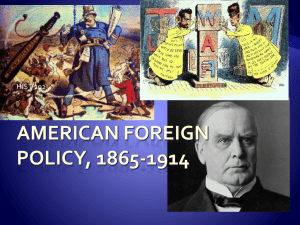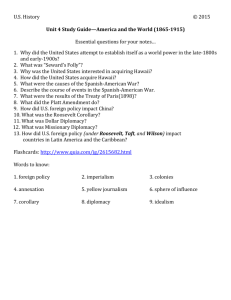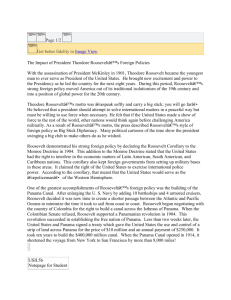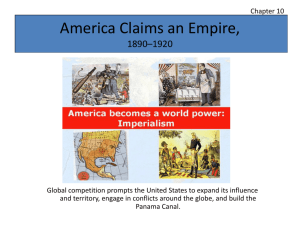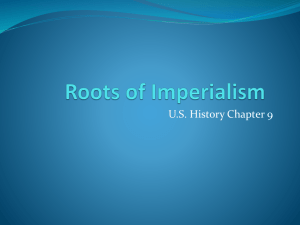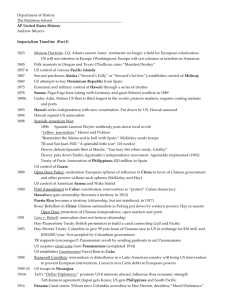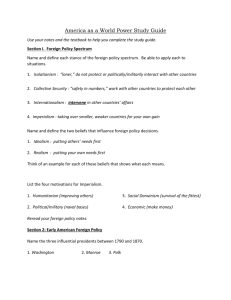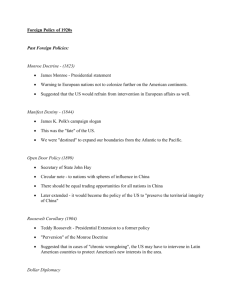Map Activity Teacher Notes 2010
advertisement
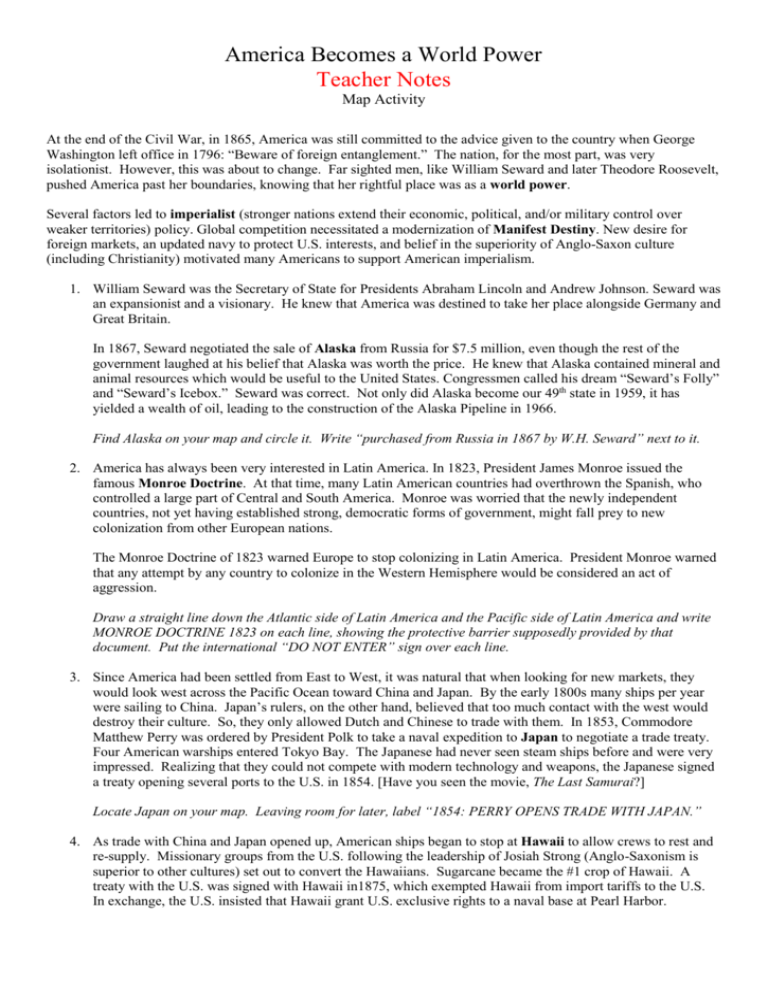
America Becomes a World Power Teacher Notes Map Activity At the end of the Civil War, in 1865, America was still committed to the advice given to the country when George Washington left office in 1796: “Beware of foreign entanglement.” The nation, for the most part, was very isolationist. However, this was about to change. Far sighted men, like William Seward and later Theodore Roosevelt, pushed America past her boundaries, knowing that her rightful place was as a world power. Several factors led to imperialist (stronger nations extend their economic, political, and/or military control over weaker territories) policy. Global competition necessitated a modernization of Manifest Destiny. New desire for foreign markets, an updated navy to protect U.S. interests, and belief in the superiority of Anglo-Saxon culture (including Christianity) motivated many Americans to support American imperialism. 1. William Seward was the Secretary of State for Presidents Abraham Lincoln and Andrew Johnson. Seward was an expansionist and a visionary. He knew that America was destined to take her place alongside Germany and Great Britain. In 1867, Seward negotiated the sale of Alaska from Russia for $7.5 million, even though the rest of the government laughed at his belief that Alaska was worth the price. He knew that Alaska contained mineral and animal resources which would be useful to the United States. Congressmen called his dream “Seward’s Folly” and “Seward’s Icebox.” Seward was correct. Not only did Alaska become our 49th state in 1959, it has yielded a wealth of oil, leading to the construction of the Alaska Pipeline in 1966. Find Alaska on your map and circle it. Write “purchased from Russia in 1867 by W.H. Seward” next to it. 2. America has always been very interested in Latin America. In 1823, President James Monroe issued the famous Monroe Doctrine. At that time, many Latin American countries had overthrown the Spanish, who controlled a large part of Central and South America. Monroe was worried that the newly independent countries, not yet having established strong, democratic forms of government, might fall prey to new colonization from other European nations. The Monroe Doctrine of 1823 warned Europe to stop colonizing in Latin America. President Monroe warned that any attempt by any country to colonize in the Western Hemisphere would be considered an act of aggression. Draw a straight line down the Atlantic side of Latin America and the Pacific side of Latin America and write MONROE DOCTRINE 1823 on each line, showing the protective barrier supposedly provided by that document. Put the international “DO NOT ENTER” sign over each line. 3. Since America had been settled from East to West, it was natural that when looking for new markets, they would look west across the Pacific Ocean toward China and Japan. By the early 1800s many ships per year were sailing to China. Japan’s rulers, on the other hand, believed that too much contact with the west would destroy their culture. So, they only allowed Dutch and Chinese to trade with them. In 1853, Commodore Matthew Perry was ordered by President Polk to take a naval expedition to Japan to negotiate a trade treaty. Four American warships entered Tokyo Bay. The Japanese had never seen steam ships before and were very impressed. Realizing that they could not compete with modern technology and weapons, the Japanese signed a treaty opening several ports to the U.S. in 1854. [Have you seen the movie, The Last Samurai?] Locate Japan on your map. Leaving room for later, label “1854: PERRY OPENS TRADE WITH JAPAN.” 4. As trade with China and Japan opened up, American ships began to stop at Hawaii to allow crews to rest and re-supply. Missionary groups from the U.S. following the leadership of Josiah Strong (Anglo-Saxonism is superior to other cultures) set out to convert the Hawaiians. Sugarcane became the #1 crop of Hawaii. A treaty with the U.S. was signed with Hawaii in1875, which exempted Hawaii from import tariffs to the U.S. In exchange, the U.S. insisted that Hawaii grant U.S. exclusive rights to a naval base at Pearl Harbor. Wealthy planters, who were mostly Anglo, pressured the Hawaiian king to accept a new constitution limiting the power of the monarch and increasing the planters’ power. Hawaiians were angered because they believed that they were losing control of their country. In 1890, economic problems triggered discontent amongst the native populations. In 1891, Queen Liliuokalani ascended the throne in Hawaii. She unsuccessfully tried to impose a new constitution that would take power back from the Anglo sugar plantation owners. She was forced to give up her throne by the planters who were backed by American troops. Planters set up a provisional government and requested that the U.S. annex Hawaii. Locate Hawaii and draw it onto your map. Label “1893: HAWAII ANNEXED BY U.S.” 5. 1890, Captain Alfred T. Mahan, a U.S. navy officer published a book titled The Influence of Sea Power Upon History, 1660-1783. In his book Mahan argued that the U.S. needed a large navy in order to protect its merchant ships and defend its rights to trade with other countries. After the navy was built, the U.S. would acquire territory for naval bases overseas to operate a navy far from U.S. This was the first true argument for American imperialism. Textbox: “Go Navy!! Captain Alfred T. Mahan advises an upgrade for the U.S. Navy fleets Senator Henry Cabot Lodge agrees and urges Congress to approve modernization Why? ..Protect overseas trade ..Protect world-wide properties ..World power needs a powerful navy!” Roosevelt helped to negotiate a peace treaty between Japan and Russia. Japan gained territorial concessions from Russia which helped U.S. and Japanese relations from 1905-1907. In 1907, the United States sent 16 warships from the new modernized U.S. Navy on a cruise around the world. It was called “The Great White Fleet.” The most important stop was in Japan. The U.S. was demonstrating that it could uphold its interests in Asia. The modern ships were painted white. Draw a picture of a ship at Japan and label it “1907: Great White Fleet.” 6. Cuba, Puerto Rico, the Philippines and the Pacific Island of Guam had been Spanish possessions for hundreds of years. They were all that were left of the old Spanish Empire. They had repeatedly tried to win their freedom but had failed. After U.S. negotiations with Spain had broken and tension increased with the sinking of the U.S. Battleship Maine, the U.S. declared war. After three months, Spain was defeated by the U.S. It was called the Spanish-American War (1898) or otherwise known as the “Splendid Little War”! With the signing of the Treaty of Paris in December of the same year, 1898, the U.S. gained the Spanish colonies. Cuba became a U.S. protectorate (country whose affairs are partially controlled by a stronger power.) Other Pacific islands would later be added. On your map label CUBA in the Caribbean and put a circle around it. Label beside Cuba “Now a U.S. Protectorate, 1898.” On your map, label PUERTO RICO. Label beside Puerto Rico “to the U.S. from Spain, 1898” next to the island. On your map, label the PHILIPPINES in the Pacific Ocean, and put a circle around it. Label beside the Philippines “to the U.S. from Spain in 1898.” On your map, draw in and label GUAM, also in the Pacific, and put a circle around it. Put “to the U.S from Spain, 1898” next to Guam. By 1900, the U.S. had several Pacific bases from which it could trade with the East (China and Japan). Steam ships needed coal to operate which was carried aboard ship. With the new territories, America could now refuel in Hawaii, Guam or the Philippines and sail longer distances. 7. China, like Africa, had been carved up into “spheres of influence” by various European powers. The U.S. insisted on its trade rights with China through a series of letters to the leaders of imperialist nations. This Open Door policy proposed that nations share their trading rights with the U.S., thus creating an “open door”. Find CHINA on the map and highlight the coastline. On the coast line, write “China: Trade established by the Open Door Policy: 1899.” 8. As far back as 1867, some Americans had dreamed of a canal that would link the Atlantic and the Pacific Ocean at the southern end of Central America. William H. Seward, the Secretary of State under Lincoln, who had overseen the purchase of Alaska from Russia, was one of the men of vision. A French company began digging a canal through Panamanian territory in 1881. By 1889, it abandoned its efforts due to bankruptcy and disease among the workers (especially malaria). The U.S. had considered digging a canal through either Nicaragua or Panama. The French company sold its digging rights through Panama to the U.S. In 1903, Panama was still a part of Colombia. Secretary of State Hay offered Colombia $10,000,000 and $250,000 per year for the right to construct and control a canal through Panama. Colombia turned it down. The U.S. encouraged and backed a revolt in Panama. Panama gained independence from Colombia and the U.S. began building its canal. Roosevelt justified this action by stating that he “had advanced the needs of collective civilization” by building a canal that shortened the distance between the Atlantic and the Pacific by 8,000 nautical miles. The Panama Canal was completed in 1913, a man-made wonder of the world. Label the ISTHMUS OF PANAMA on your map and highlight it. Label “Panama Canal: built 1903-1913” 9. The growing American involvement in foreign affairs caused Roosevelt to expand his “Speak softly, but carry a big stick” diplomacy. In 1904, Roosevelt defined what came to be known as the Roosevelt Corollary to the Monroe Doctrine. To prevent European nations from sending troops to the Caribbean or Central America, he announced that the U.S. would intervene in Latin American affairs when necessary to maintain stability in the Western Hemisphere. Roosevelt first applied the corollary in the Dominican Republic, which had fallen behind in its debt payments to European nations. Roosevelt sent marines into Dominican Republic in 1905 to collect customs tariffs to make debt payments because he was afraid that European nations would send troops in. Find the DOMINICAN REPUBLIC on your map and shade it in. Label: “1905: Dominican Republic Roosevelt Corollary. In 1911, U.S. bankers began making loans to Nicaragua to support its financially shaky government. The following year civil unrest forced the Nicaraguan president to appeal for greater assistance. U.S. marines entered the country, replaced the collector of customs with an American agent, and formed a committee of two Americans and one Nicaraguan to control the customs commissions. American troops stayed until 1925. Find NICARAGUA on your map and shade it in. Label: “Nicaragua: Roosevelt Corollary 1911-1925 10. President Taft: American businesses were encouraged to invest in foreign countries. This allowed US to influence a region economically. Taft claimed this “substituted dollars for bullets” and would advance American interests and policy throughout the world by commercial means while raising the standard of living in the region and promoting political stability. “Dollar Diplomacy” was used mainly in Latin America. Find Latin America on your map. Shade it in lightly in green and label it “Dollar Diplomacy.” 11. In 1913, Woodrow Wilson added a moral tone to the Monroe Doctrine called “Missionary Diplomacy”. According to Wilson, the U.S. had a moral responsibility to deny recognition to any Latin American government it viewed as oppressive, undemocratic, or hostile to U.S. interests. When General Victoriano Huerto took over the Mexican government and executed its leader, Francisco Madero, in 1913, President Wilson refused to recognize the new government.
